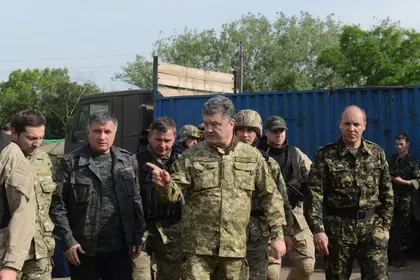“We will attack and we will liberate our land. The end of the ceasefire is our response to terrorists, rebels, looters, all those who mock the civilians who paralyze the economy of the region; who rip the payment of salaries, pensions, stipends; who undermine the railroads, destroy water pipes, those who deprive a normal peaceful life,” according to a statement on Poroshenko’s website that he broadcast to the nation early this morning.
Poroshenko’s move is a highly risky bid to end the separatist uprisings that began in April and have claimed the lives of more than 180 Ukrainian servicemen, including at least 27 since the ceasefire was announced on June 20.
JOIN US ON TELEGRAM
Follow our coverage of the war on the @Kyivpost_official.
Poroshenko announces the end of the ceasefire and the resumption of Kyiv’s military operation in a video address on July 1.
“Expectations now are that a further and very large scale Ukrainian military assault on rebel forces will be forthcoming over the next few hours. There have been reports that Ukrainian forces have been moving significant armed formations up towards rebel held positions over the past few hours,” Timothy Ash, an analyst with Standard Bank in London wrote. “Presumably Poroshenko was not convinced that Russian President Vladimir Putin was being sincere in efforts towards peace, and also did not view Western efforts/threats of further sanctions on Russia as being serious enough to counter Russian support of proxy forces in Donetsk and Luhansk. Kyiv seemingly has decided to take matters into its own hands and try and retake the initiative in southeastern Ukraine.
“This will be a key test for the Ukrainian armed forces, and the first real test of the Poroshenko presidency,” Ash wrote. “Also let’s see how Russia reacts to a presumed large scale Ukrainian military offensive, with presumably the risk of significant casualties on the ground, including to the large number of Russian citizens reported to be amongst the fighters in Donetsk and Luhansk. Poroshenko is presumably taking a gamble that Russia will not risk being dragged into a more direct military conflict in Ukraine for risk of heightened Western sanctions. Suffice to say that this crisis is now moving to a new and still very serious/high risk phase.”
On June 30, the Foreign Ministry said Moscow-fueled separatists launched at least 108 attacks against Ukraine’s army since the truce was announced, killing at least 27 soldiers.
A Voice of America alert quoted General Philip M. Breedlove, the NATO commander, as saying that Russian military forces are actively assisting the movement of forces, equipment and finances into Ukraine. “There are several types and capabilities of heavy weaponry that are moving across the border,” Breedlove was quoted as saying.
Radical party leader Oleh Liashko posted on his Facebook page that Ukraine’s anti-terrorist operation has resumed and that martial law would be imposed. Liashko ended his message with: “God help Ukraine! Glory to Ukraine! Death to its enemies!”
On June 30, Putin urged Poroshenko to continue the ceasefire, according to a Kremlin statement released after a phone call that also included French President François Hollande and Germany’s Chancellor Angela Merkel.
Russia has done little to bring peace, despite the fact that the European Union ultimatum for Russian action came to an end at 10 p.m. on June 30. The EU threatened with a third round of sanctions if Russia did not work for peace.
The United States have made an early signal that they will support Poroshenko’s decision. State Department spokesperson Jen Psaki said during her daily press briefing on June 30 that a ceasefire extension is up to Ukraine, and that the U.S. will support whatever decision the president makes.
On top of resumption of the anti-terrorist operation, Poroshenko is said to be contemplating major changes to the heads of law enforcement agencies, steps that also will require parliament’s approval.
He consulted independent deputies in parliament earlier today on this issue.
Anatoliy Hrytsenko, a former defense minister who was present at the meeting, said the president announced cleanup of law enforcement commandment at the meeting.
“There are three
staffing decisions planned: change of commander of headquarters (it’s
within presidential powers) , and introduction in the Rada and
appointment of the minister for defense and vice prime minister who
will coordinate in the government the law enforcement and defense
sectors, primarily their material and technical supplies and
logistics,” Hrytsenko said on his Facebook page.
He said the
president planned to decide on the candidates today. Hrytsenko also
said that heads of the Security Service, interior ministry and border
guard will likely remain in place.
You can also highlight the text and press Ctrl + Enter



